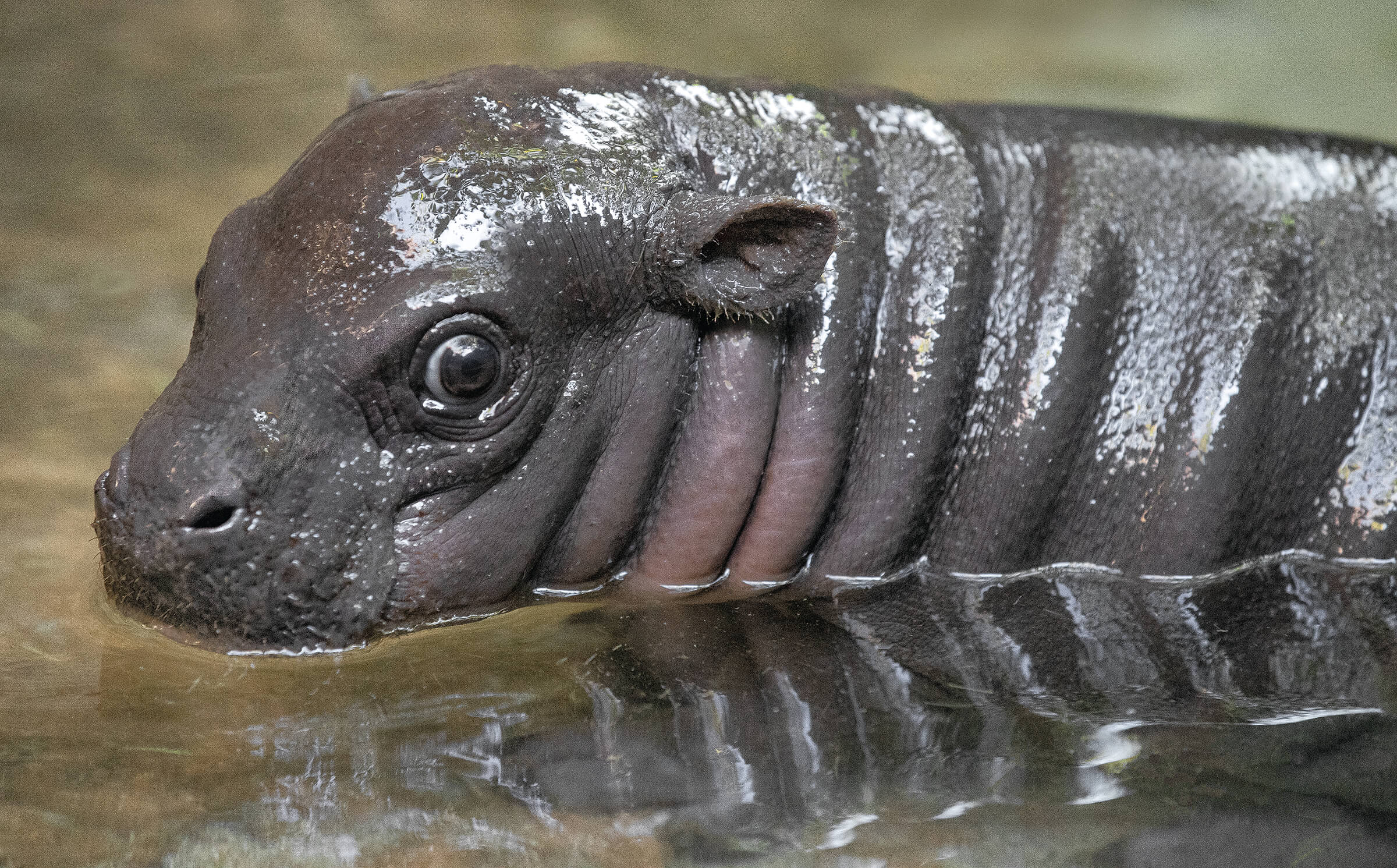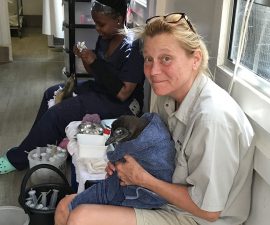The Zoo’s pygmy hippo has made quite a first impression
BY Karyl Carmignani
Photography by Ken Bohn
Mabel was made for motherhood. The Zoo’s animal care staff plotted, planned, and problem-solved for months in advance for every birthing outcome imaginable; but the 660-pound pygmy hippo took to caring for her 12-pound calf like a fish to water. Wildlife care experts were relieved the birth went smoothly, and remained cautiously optimistic that the tiny calf would survive. “The calf survival rate in this species is low, and it is not uncommon for first-time moms of many species to have more problems with pregnancy and infant rearing,” explained Deena Brenner, DVM, senior veterinarian, San Diego Zoo.
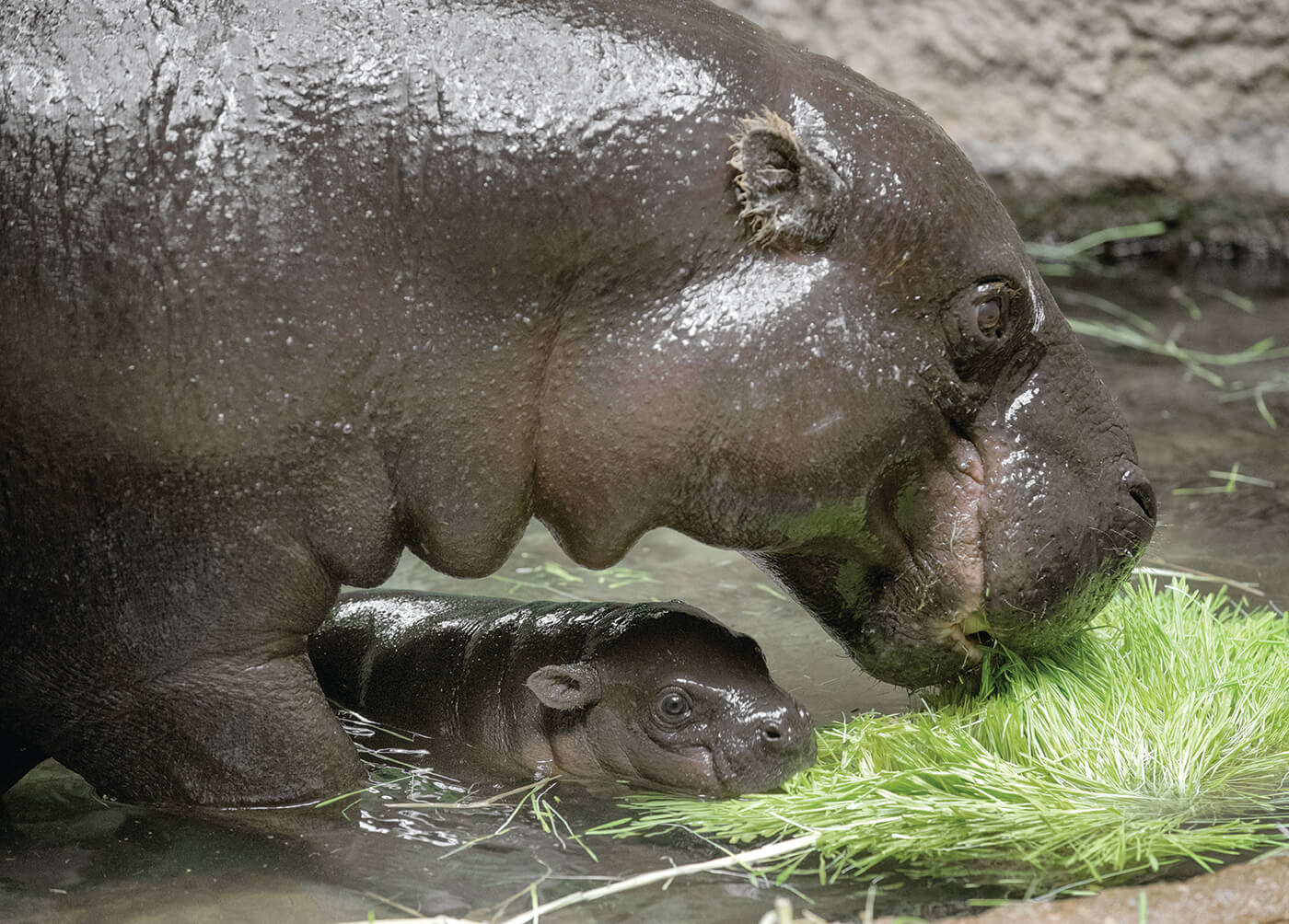
ROLLING ON
Mabel’s calf is thriving under her watchful eye! The little male, Akobi, mimics his mom’s pygmy hippo behaviors, from enjoying the pool to munching on greens. The two can be observed in their habitat in Lost Forest at the Zoo.
She and the rest of the team—vets, wildlife care specialists, and neonatal and nutrition experts—are elated that Mabel and the calf have remained strong and healthy. The calf, named Akobi, continues to meet or exceed developmental milestones and bond with his calm and attentive mom. “We couldn’t have asked for a better outcome,” said Dr. Brenner.
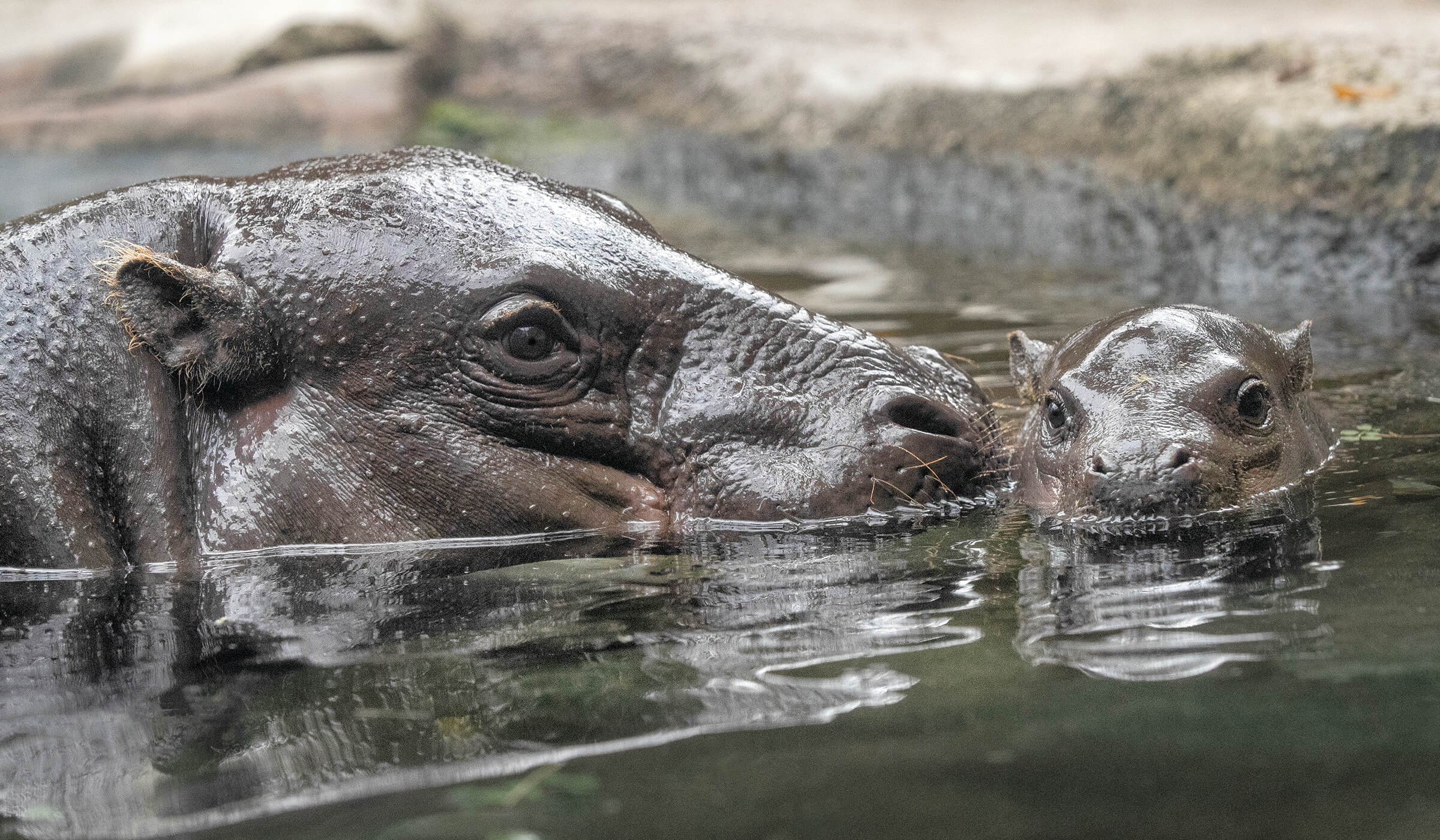
Walk on the Wild Side
Pygmy hippos Choeropsis liberiensis are secretive, and little is known about their habits and maternal behavior in their native-range countries. Found in the forests and swamps of West Africa, primarily in Liberia, with small populations dotting Sierra Leone, Guinea, and Ivory Coast, they are notoriously difficult to track and observe. Shy and nocturnal, they generally stick to deep, tunnel-like paths through the underbrush to forage near rivers, streams, and swamps.
While they loosely resemble their gigantic relative the river hippo, the pygmy hippopotamus is distinctly different. This pint-sized herbivore is much less aquatic than its cousin, and therefore has less webbing between its toes. Its eye placement is also lower on the face, and its legs are a bit longer, relatively speaking. Pygmy hippos are listed as Endangered on the International Union for Conservation of Nature (IUCN) Red List of Threatened Species. Historically, they ranged far and wide across West Africa, but human activities like logging, farming, and increasing human development have led to a significant decline in their populations. Currently, fewer than 2,500 pygmy hippos exist in Africa.
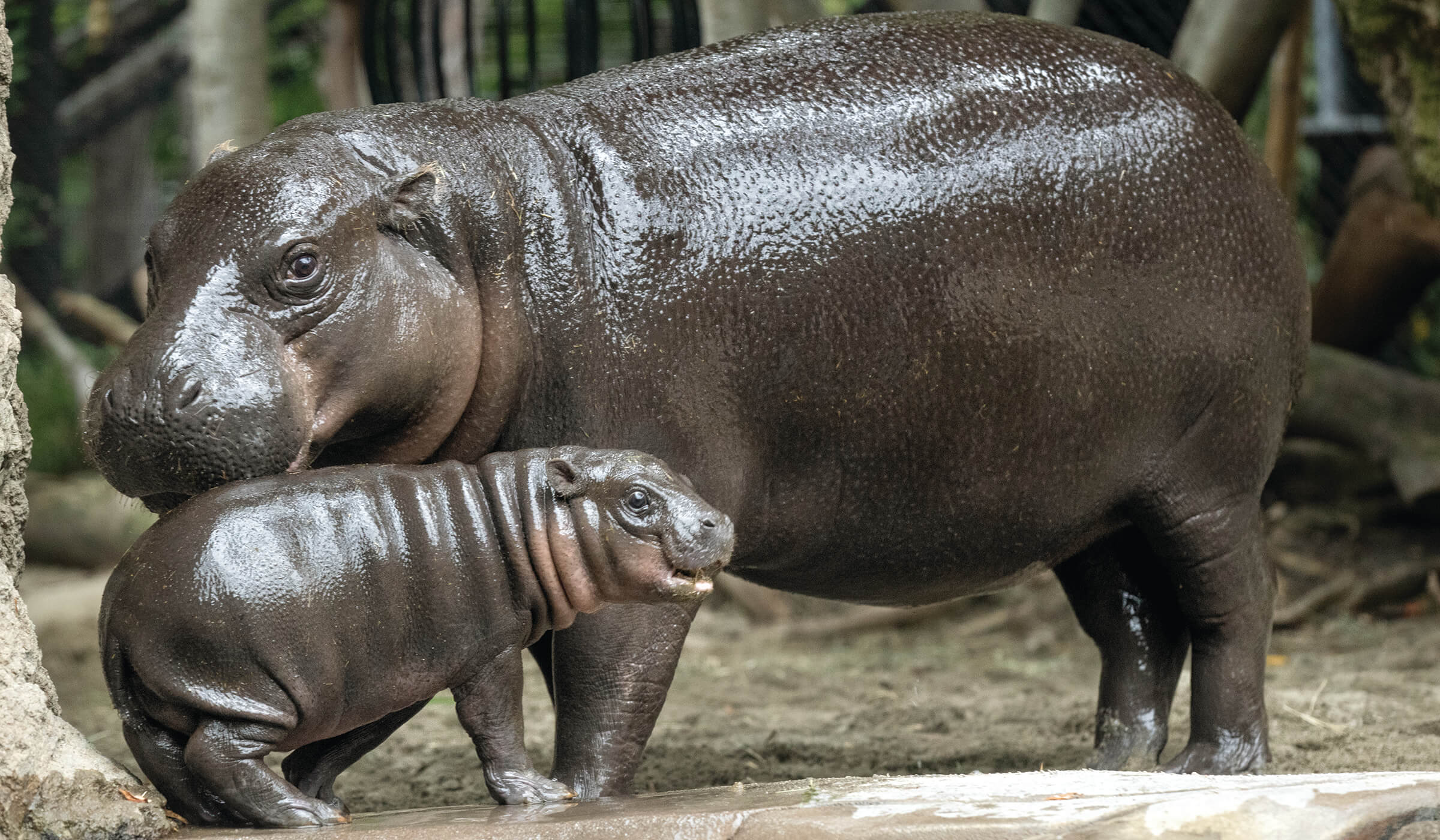
Big and Brave
At the San Diego Zoo, the pygmy hippos share their habitat with acrobatic monkeys: two lesser spot-nosed guenons Cercopithecus petaurista and two Wolf’s guenons C. wolfi, which add significant flair (and enrichment) to the habitat. Mabel and her calf spent time in their maternity area away from the primates initially, but they are gradually being introduced as the animal care staff monitors the interactions. Male pygmy hippos are not involved in calf rearing, so Akobi’s father, Elgon, does not spend time with Mabel and the calf.
Tipping the scales at around 60 pounds as of this writing, the rotund calf is still getting most of his nutrition from nursing, and a small amount from his mom’s food pellets and mouthing her greens. Leanne Klinski, wildlife care specialist, described another interesting behavior: pygmy hippo mothers typically lie down to nurse their calf, but this calf insists on nursing standing up. “He just positions himself underneath her,” and Mabel accommodates him.
The dynamic duo is doing great, spending time on the beach and in the pool. Mabel is protective and watchful over her calf. She is always mindful of the little guy, and “nudges him into shallow water when she thinks he’s in over his head,” said Leanne. She said that while pygmy hippos are typically “hiders,” stowing their young in the brush hidden from predators for the first couple of weeks, Mabel’s calf insists on being a “follower,” tagging along wherever she goes. “He’s very brave! He is writing his own story.”
Preparations for a Rare Birth
Given the rarity of this species in zoos, and its endangered status throughout its range, it’s no wonder months of preparation went into this special birth event. Pygmy hippos reach sexual maturity around 4 years old—Mabel’s age—with a gestation period of 180 to 210 days. Wildlife care staff had been working with Mabel on mock ultrasound training, getting her accustomed to the different sensations and behaviors so her health could be monitored. This prepared her for the real deal later on.
It takes baby steps—and positive reinforcement—to elicit the desired behaviors and keep stress levels low. “We wanted her to feel comfortable with the ultrasound,” said Dr. Brenner. “Happily, she readily participated in ultrasound exams throughout her pregnancy, which allowed us to track the calf’s growth and development. Mabel is the best!”
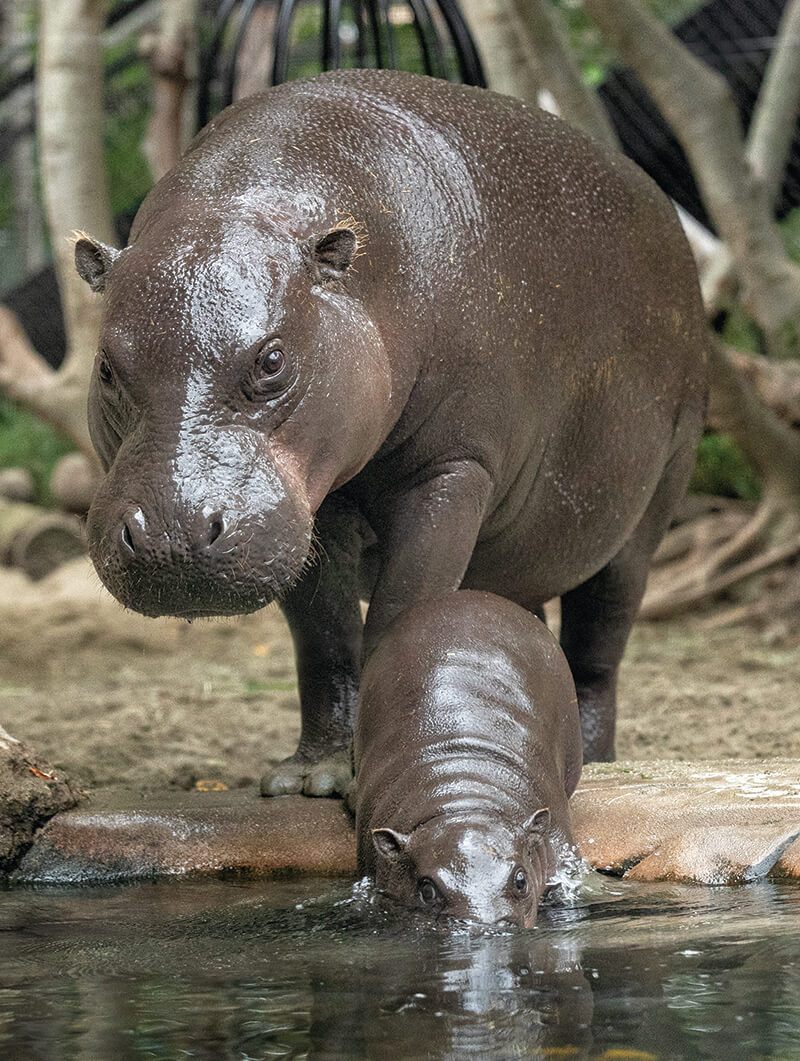
GETTING “HIP”
While pygmy hippos are less aquatic than river hippos, they still spend a fair amount of time in the water. Mabel is ready to rescue and protect her calf as he learns the ropes.
A state-of-the-art, portable ultrasound machine was acquired, which could read through her side and provide detailed images. The pygmy hippo habitat was modified to ensure the safety and well-being of the calf, including additional heaters, misters, and some changes to the maternity pool. Perhaps most helpful was the installation of cameras in the maternal area. “Remote monitoring meant we could closely observe her labor and the birth without disturbing her,” said Dr. Brenner. “This gave us the opportunity to determine whether any medical interventions were needed.”
Fortunately, the birth went off without a hitch, and Akobi continues to thrive. Mabel’s maternal instincts are spot on. “It’s amazing to watch Akobi surpass developmental milestones,” Dr. Brenner added. Mabel and Akobi are helping to rewrite the story for their special species.

